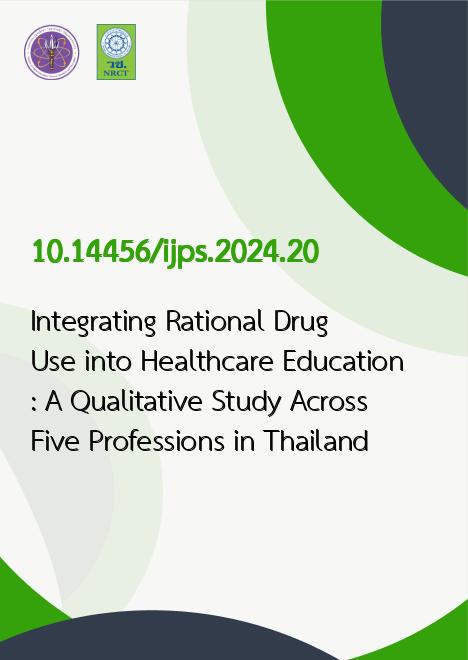
|
Integrating Rational Drug Use into Healthcare Education: A Qualitative Study Across Five Professions in Thailand |
|---|---|
| รหัสดีโอไอ | |
| Creator | Sisira Donsamak |
| Title | Integrating Rational Drug Use into Healthcare Education: A Qualitative Study Across Five Professions in Thailand |
| Contributor | Siritree Suttajit, Puckwipa Suwannaprom, Teeraporn Sadira Supapan, Rojjares Netthong |
| Publisher | Faculty of Pharmaceutical Sciences KKU MSU UBU |
| Publication Year | 2567 |
| Journal Title | Isan Journal of Pharmaceutical Sciences |
| Journal Vol. | 20 |
| Journal No. | 4 |
| Page no. | 17-35 |
| Keyword | rational drug use, rational use of medicine, healthcare professional education, educational activities, curriculum |
| URL Website | https://tci-thaijo.org/index.php/IJPS |
| Website title | Isan Journal of Pharmaceutical Sciences, IJPS |
| ISSN | 19050852 |
| Abstract | The irrational use of medicines is a global public health challenge, contributing to adverse patient outcomes, antimicrobial resistance, and escalating healthcare costs. Rational Drug Use (RDU) is critical to addressing these issues by promoting safe, effective, and appropriate medication use. However, integrating RDU into healthcare education remains inconsistent across professions. This study aimed to explore the initiatives and strategies employed by healthcare professionals and academic faculty to promote the education on RDU and incorporate its principles into their respective curricula. Material and Methods: A qualitative study was conducted to gather data between May and June 2023. Seven focus group discussions were conducted with 36 participants, including 17 members from professional councils and dean consortiums, and 19 faculty administrators and lecturers across five healthcare professions: Medicine, Dentistry, Pharmacy, Nursing, and Veterinary Medicine. Discussions followed a researcher-developed topic guide and were recorded, with verbatim transcripts subjected to thematic analysis. Results: Six major themes emerged: (1) The Memorandum of Understanding (MOU) formalized RDU competencies, requiring their inclusion in curricula and national licensing exams. (2) Professional councils and dean consortiums played key roles in setting accreditation standards and ensuring that RDU competencies are part of graduate qualifications. (3) The development of profession-specific RDU teaching guides led to variation in awareness and implementation across institutions. (4) Inconsistent management of RDU education was observed, with significant differences before and after the MOU's introduction, leading to uneven progress across institutions. (5) A lack of standardized methods for assessing RDU learning outcomes hindered consistent evaluation of student competencies. (6) RDU in licensing exams was unevenly emphasized, with stronger incorporation in nursing and veterinary medicine compared to other fields. Conclusion: Despite progress in RDU integration, significant gaps remain in standardization and assessment across healthcare professions. Strengthening collaboration between councils and institutions is essential for improving RDU education, ensuring healthcare graduates are better equipped to promote RDU and patient safety. |
